Both Nativeborn Americans and Immigrants Produced Works of Art Music and Literature

Consuelo Álvarez de Medina, 52, has been picking grapes in California's fertile Central Valley for many years. "This is the life for usa Latinos hither. Work to live, day to twenty-four hour period," she says. (Photograph by Lauren Irwin/News21)

Maung Maung, left, and Than Than Nu Saw, a wife and married man team from Myanmar and Malaysia, gear up bao, a meat- or vegetable-filled steamed flour bun. They're trying to popularize dim sum in America. (Photo by Lauren Irwin/News21)
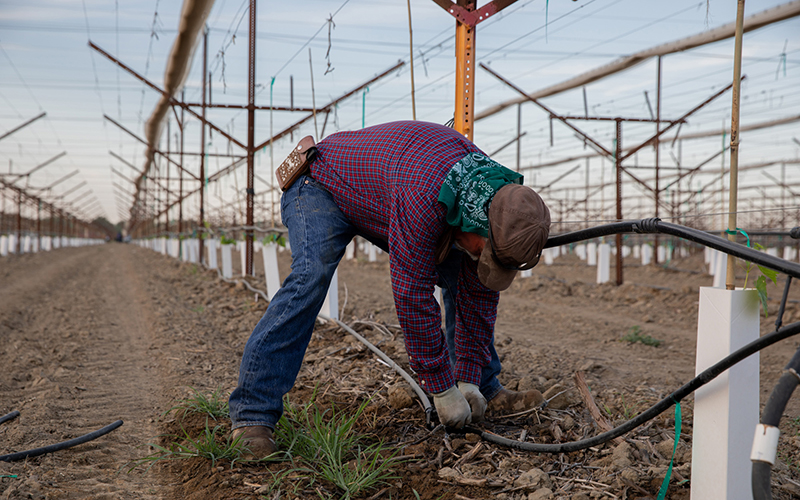
A farm worker fixes and tests an irrigation system at a family unit subcontract most McFarland, California. (Photo by Lauren Irwin/News21)
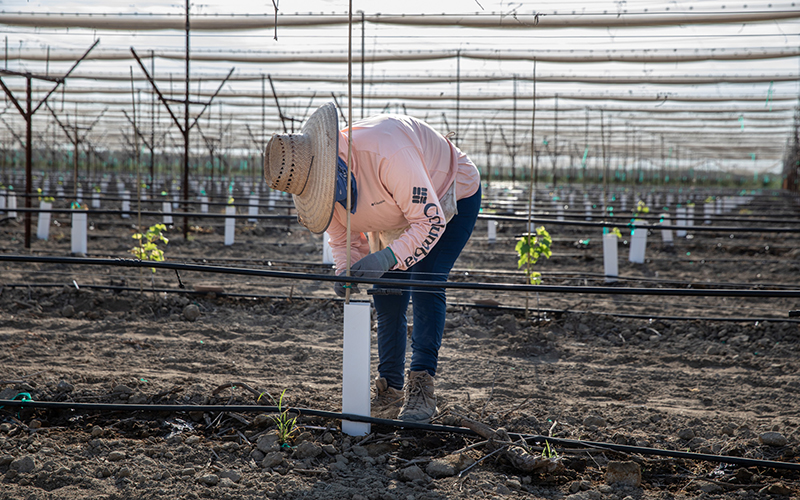
A worker secures a grape vine to a bamboo stick in the early on morning at a family subcontract near McFarland, California. (Photo by Lauren Irwin/News21)
As the sunday beats down on a family farm in McFarland, California, immigrant workers duck under a leafy canopy of cotton-candy grapes for a moment of relief. It'south 5:56 a.one thousand., and temperatures are speedily rising.
Draped in cotton from fingers to toes, with only their eyes exposed to the sun, the workers constitute, option and prune vi days a week, row after dusty row, year after year. Norteño music beats a country tune in the groundwork as they talk with each other over breakfast tacos.
"Pruning the vineyard is harder for a woman, only we all do information technology," Consuelo Álvarez de Medina, 52, said in Spanish. She has picked grapes for nearly two decades. "This is the life for united states of america Latinos here. Work to live, mean solar day to twenty-four hours."
Immigrants are the foundation of subcontract to table, especially during a pandemic. Immigrant workers in America are the people who work in fields, cook and bundle takeout orders in restaurants, and mop the floors and stock shelves at grocery stores.
Amongst the nation's l million immigrants from more than 150 countries, most are more probable to be service, structure and transportation employees than native-born workers, according to the Agency of Labor Statistics. They include refugees who get small concern owners, similar the corner Middle Eastern restaurant or the Indian grocery store. Even before the pandemic, they were considered essential employees only, advocates say, were often disregarded.
Immigrants take the riskiest jobs, are paid low wages and have been the most vulnerable to wellness complications throughout the pandemic, while ofttimes non qualifying for the government benefits handed out to other Americans.
"We do a great disservice to the families … we prepare up a system that is difficult to break free from," said Elliot Lepe, a Georgia resident and a paralegal at the Southern Poverty Law Center. "It'due south hard to have savings. It's hard to have retirement. Their bodies break downwardly. It just solidifies poverty … poverty that is hard to escape."
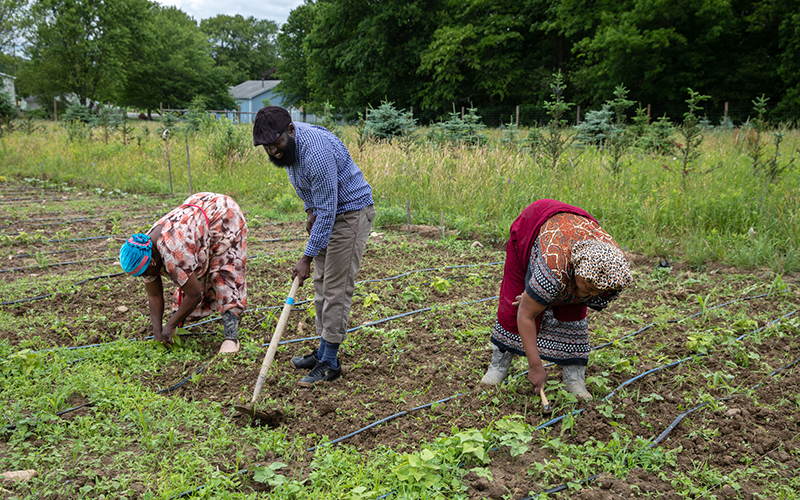
Msemewa Mchidewa, left, Hamadi Ali and Safi Anzuruni, right, tend to the Congolese community plot at Providence Subcontract Collective on the outskirts of Buffalo, New York. (Photo by Lauren Irwin/News21)
From farm to table
From the Appalachian Trail in Georgia to the Fundamental Valley in California, immigrant subcontract work accounts for nearly 75% of the land's agronomical production, from basics like potatoes and almonds to high-end products like cotton-candy grapes found at upscale grocers.
Margarita Ortega, who spent eight years equally a grape picker in the farming community of Delano, California, described the obstacles that kept coming during the pandemic. First, the fright of COVID-19 hovered over the fields.
Her husband, Juan Lozano, who is diabetic, had his right foot amputated. Both quit to protect the family unit'due south health. They weren't aware of organizations offering rent relief, so they were left to accumulate loans. In outcome, Margarita became the sole caregiver of their five children.
"I have raised my children from the grapes," she said in Spanish, shaded under the grape vines to be exported to Australia and Communist china. "Everything is from this chore, fifty-fifty if it is hard work."
Ortega gazes at her fellow workers, reaching high to snip the produce from its root in a vineyard that stretches for 1,500 acres.
"Nobody is going to do these jobs," she said. "Nobody."
Terminal March, as Americans rushed to buy groceries, grabbing toilet newspaper, produce and canned goods from most empty shelves, immigrant farm workers captivated the repercussions.
According to Álvarez de Medina, subcontract owners would not pay their employees overtime, opting instead to pay a bonus.
"Correct at present the minimum is $xiv.25 an hour, merely when we pick the grapes, it is 50 cents of bonus per box. So the more boxes we fill, we earn a piddling more," Álvarez de Medina said about the twenty-pound grape boxes. "They gave us an extra $20 to come every day, because people are very scarce."
Hernan Hernandez, the executive manager of the California Farmworker Foundation, said Central Valley pickers are "harvesting the fresh fruit to the world but don't take access to it themselves."
Hernandez has watched as wellness issues, low wages and a housing crisis unfolded in rural Delano over many years, exposed further by the pandemic. The California Public Health Department said information technology required local health jurisdictions to request COVID-nineteen tests and vaccines, but Hernandez said the eight counties in the Central Valley were terminal in line for them.
"There's no reason why L.A. and the Bay should always get all the resources," he said. "I think the Cardinal Valley has always been that area in the state where it always gets left behind."
The public health department looked at factors such equally "existing resources, local disease spread and local testing rates," a public health spokesperson said in an email. It was up to each county to request aid, he wrote. Gov. Gavin Newsom sent additional aid to the Central Valley once infection rates were on the ascent in July 2020.
On the other side of the land, Matt Tice, who oversees an immigrant shelter in Buffalo, New York, said the city fell in the shadow of New York City's boroughs in pandemic-relief efforts.
"Needing to remind them is often the chore of local officials … and other nonprofits and community groups (to) make sure (the governments) call up the residuum of u.s.a.," Tice said.
Back on the West Coast, Hernandez agreed.
"I retrieve there were systematic regime failures that we should acquire from, particularly when it comes to the Hispanic population and the way we interacted with them," Hernandez said. "I do still believe that the most vulnerable populations were the ones that were well-nigh severely affected from this pandemic."
Farmworkers, considered essential workers by the authorities, were even more vulnerable as supplies of N95 masks dwindled. They no longer had access to the masks needed to protect them from pesticide applications, wildfires and the virus.
Female immigrant farmworkers in Kern Canton, California are filling many roles every bit they raise children, manage families and lead crews who are cultivating grapes to satisfy America's need for food during the COVID-19 pandemic. (Video by Natalie Saenz and Priya Bhat/News21)
Depression wages and big risks
Undocumented workers are particularly at risk of low wages and benefits — receiving little to no government relief over the past 17 months.
Pablo Bautista, a 40-twelvemonth-old undocumented janitor in Phoenix, Arizona, was laid off in early March 2020 and couldn't observe another task. Since he didn't qualify for a stimulus check or unemployment benefits, information technology was difficult to provide for his married woman and five children.
He now works the dark shift — 6 hours a day, for $12 an hour — at a supermarket concatenation.
"I'grand yet scared. I don't know what'southward going to happen," Bautistsa said in Spanish, explaining he is worried nearly his family, his work and the virus.
The Bureau of Labor Statistics reported that in 2020, foreign-born workers earned $885 for every $1,000 paid to native-born workers. Hispanics business relationship for nearly half of the immigrant labor force, all the same their salaries were 86.7% of those of native-built-in workers.
"If this country really respected and really was cognizant of their compensation for the most essential … workers … yous can't assist but retrieve, how much better would my parents exist off?" Lepe asked. "Paying a few actress cents at the grocery store for people to have dignified lives is a price that we should all exist willing to pay."
As the son of blueberry pickers, Lepe watched his father pay the toll over 30 years of piece of work, his body crippling after decades bent over. He never made enough money to build up savings. He adult heart disease, and other ailments, then died of a center assault three years ago.
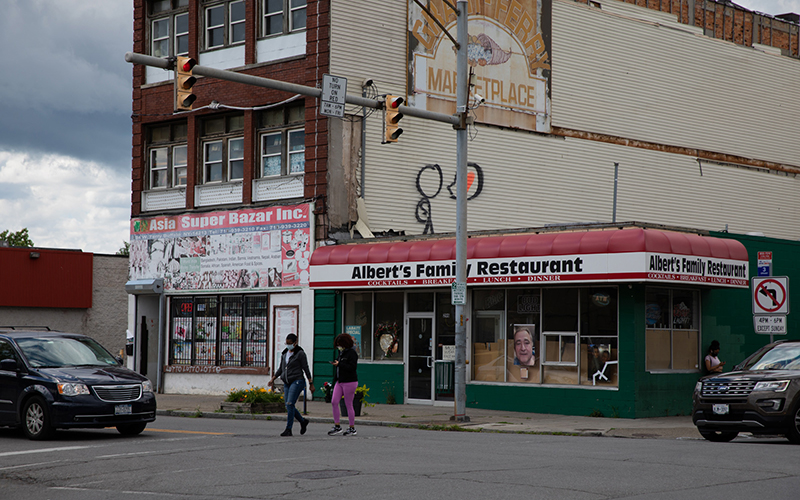
Immigrants and refugees have revitalized storefronts along once-empty Grant Street in Buffalo, New York. (Photo by Lauren Irwin/News21)
Revitalizing the due west side
Buffalo — a manufactory town that borders Lake Erie and Canada — is divided among racial and indigenous neighborhoods, except for the west side. There, shop owners from across the world, including people from Somalia, Federal democratic republic of ethiopia and Myanmar, are edifice businesses to prop upwards the Rust Chugalug city. The Pew Research Heart constitute that a majority of immigrants are moving to urban areas, reshaping the landscape and the economy.
"At that place used to exist many more than just stripped blocks of nothingness — shovel-ready sites, they called them," said Erin St. John Kelly, spokesperson for Wedi, a Buffalo arrangement that provides microloans to business owners in Erie and Niagara Counties. "Immigrants who come to Buffalo … are really part of what'due south economically driving the health of the city. It'due south not top-down money from the authorities."
In 2019, the foreign-born population generated six.six% of Buffalo's gross domestic product — pregnant the more 2,000 immigrant businesses contributed $4.9 billion to the metro surface area'due south total $73.8 billion GDP, New American Economy said. Immigrants are twice as likely to commencement their own businesses as native-born Americans, the National Clearing Forum constitute.
A decade ago, boarded-upward storefronts, broken windows and trash littered Grant Street, a strip on the west side of Buffalo. Over the years, shops owned past immigrants from across the globe moved in to revitalize the expanse. But the streets went silent during the pandemic.
One day in June, the street was buzzing again. People walked into the Indian grocery store to buy Thai chiles, back-scratch powder, garam masala and other spices, and buy a bedroom ready at the boutique piece of furniture and clothing store. They stopped by the halal market for canned goods and picked upward pilus care products and confront wash at the local Sudanese-endemic cosmetic supply store.
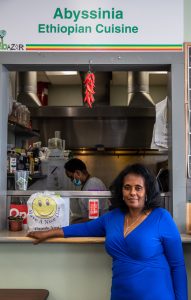
Zelalem Gemmeda at her restaurant stall at the W Side Boutique in Buffalo, New York. (Photo by Lauren Irwin/News21)
Zelalem Gemmeda, a refugee from Ethiopia, brought her sourdough flatbread and pita plates to the Due west Side Bazaar food court on Grant Street, opening Abyssinia Ethiopian Cuisine eight years ago. She tried to keep it open for as long every bit she could during the pandemic, merely eventually she had to pivot to takeout but. She reopened fully in early June.
"I'm so blessed and thankful for being here because I could … become my dreams in America," she said.
The opportunity to be her ain boss has immune Gemmeda to put both of her children through university programs and to visit her family in Federal democratic republic of ethiopia, she said.
"Surrounded past other refugees, nosotros have become like a family unit now," Gemmeda said, adding that the nearness of other refugees makes her feel at home in Buffalo.
Just the city'due south variety also led to linguistic communication and cultural barriers in the pandemic. Immigrant business organisation owners in Buffalo had less access to government funding and were often misinformed almost how to handle COVID-19 precautions, said Michael Moretti, the operations manager of the West Side Bazaar.
He said in the absence of communication from the government, he had to provide answers to their questions, even when those answers might not make sense — Why were major retailers like Target allowed to remain open while their merchandise gathered dust backside their storefronts?
"They run across me as, like, a trusted American person that they can come to with basically anything," Moretti said. "There'south no local Burmese news sources … so people are going based on what their friends said, people are going based on what loose translations they had."
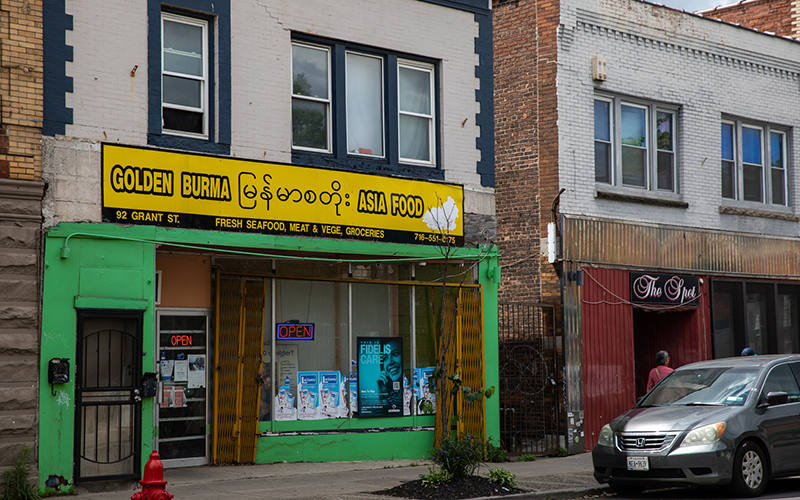
Storefronts mostly owned past refugees offering a diverse range of nutrient and goods along Grant Street in Buffalo, New York. (Photo by Lauren Irwin/News21)
Anna Mongo, the former director at Vive, a northward Buffalo immigrant shelter, likewise saw the disparities of language and cultural barriers. Without a trusted source or translated information, many immigrants frequently were left wondering what to believe about the pandemic.
"I think they got the data later than the rest of u.s.," she said. "I think they have more than reason to not trust government information than the rest of us."
Looking ahead
Wage reform, government benefits and accessibility to public health information for immigrants have gained national attention during the pandemic. Advocates are working to garner more than back up from the federal and country governments, but nothing has been promised.
Discussions sparked the Raise the Wage Act and revitalized the Fight for $15 move in January 2021, after the pandemic highlighted the disparities in workplaces. The Economic Policy Institute reported that Hispanic workers — specifically Hispanic women — would disproportionately do good from a wage raise, lifting many essential workers out of poverty.
The National Clearing Forum, an organization that aims to educate and advocate for bipartisan clearing reform, created the "All of U.s." campaign to bear witness the value of immigrant labor in America.

Immigrant farm workers gather at the end of their shift at a subcontract in McFarland, California. (Photo by Lauren Irwin/News21)
"We fabricated a indicate of saying, expect, it's going to take … anybody who … lives hither, who resides here, to get united states of america through," said Dan Gordon, a spokesperson for the organization. "That includes native-built-in Americans and immigrants working shoulder to shoulder."
Some other advocacy grouping, FWD.us, wants lawmakers to open up a path to citizenship for undocumented workers, and then they can get benefits such as stimulus money, business concern loans and the relief of knowing they accept a safety net.
"Lawmakers recognize that we have an enormous opportunity ahead of us to really reform our broken immigration system into something that serves our families and something that can improve our economy," spokesperson Leezia Dhalla said.
Ortega, the former farmworker, said the Biden administration needs to step up.
"I hope the president sees the … importance of giving immigration reform now for all farmworkers," Ortega said. "Because, actually, they are very valuable to the field."

Source: https://cronkitenews.azpbs.org/2021/08/18/from-farm-to-table-immigrants-feed-america/
0 Response to "Both Nativeborn Americans and Immigrants Produced Works of Art Music and Literature"
Enviar um comentário